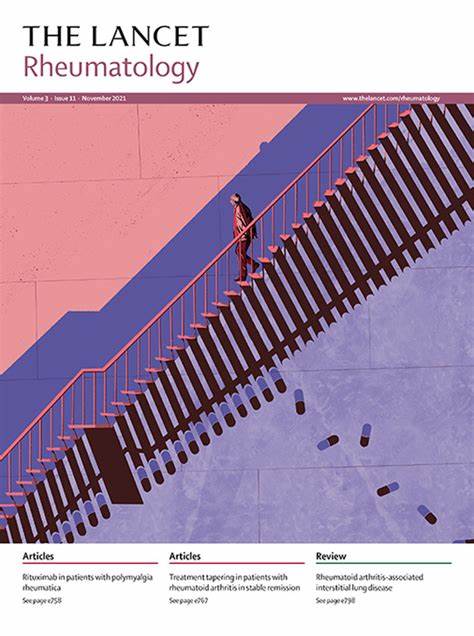边缘区淋巴瘤的治疗方式与总生存率、血液学反应和潜在的斯约格伦病活动性:一项多中心、回顾性、观察性研究。
IF 15
1区 医学
Q1 RHEUMATOLOGY
引用次数: 0
摘要
背景:斯约格伦病是淋巴瘤发病风险最高的自身免疫性疾病。对于治疗并发淋巴瘤的斯约戈伦病的最佳方法,目前尚无共识。我们旨在描述与斯约戈伦病相关的非霍奇金淋巴瘤的特征、治疗策略和结果,以及它们对淋巴瘤和斯约戈伦病预后的影响:我们进行了一项多中心、回顾性、观察性研究,纳入了根据2016年美国风湿病学会-欧洲抗风湿联盟标准确诊的、不符合其他结缔组织疾病诊断标准的斯约戈伦病患者。我们纳入了在 2020 年 1 月 1 日前确诊为淋巴瘤的患者,这些患者来自法国巴黎的两个专家中心、法国多中心前瞻性斯约格伦综合征系统体征和演变评估队列,以及在风湿与炎症俱乐部注册的执业医师。采用逆治疗概率加权法,比较了淋巴瘤治疗效果与三个终点的关系:淋巴瘤无进展生存期、新的斯约格伦病全身活动度和总生存期。探索性分析还旨在确定与淋巴瘤复发、新发斯约格伦病全身活动性和总生存期相关的因素。有生活经验的人没有参与这项研究:研究共纳入了 106 名罹患淋巴瘤的斯约格伦病患者。最常见的组织学亚型是粘膜相关淋巴组织淋巴瘤(106 例患者中有 68 例[64%]),其次是其他边缘区亚型(106 例患者中有 14 例[13%])和弥漫大 B 细胞淋巴瘤(106 例患者中有 14 例[13%])。在82名边缘区淋巴瘤患者中(女性72人[88%],男性10人[12%];淋巴瘤确诊时的平均年龄为57-5岁[SD 14-8]),多变量分析显示,肺部定位与死亡率有关(危险比[HR] 7-92 [95% CI 1-70-37-0])。在82名边缘区淋巴瘤患者中,有19人(23%)采用了观察和等待的方法,13人(16%)接受了一线局部治疗(手术或放疗),50人(61%)接受了一线系统治疗。中位随访7年后,26名患者(32%)淋巴瘤复发,9名患者(11%)死亡,27名患者(33%)出现新的系统性活动。在对治疗概率进行反向加权后,淋巴瘤确诊时接受系统治疗的患者出现新的斯约格伦病活动的风险降低(HR 0-43 [95% CI 0-21-0-90])。将接受化疗和抗CD20联合疗法治疗的患者(32人)与接受单一疗法治疗的患者(18人)作为淋巴瘤一线疗法进行比较,发现接受联合疗法治疗的患者淋巴瘤无进展生存期有所改善(HR 0-36 [95% CI 0-14-0-94])。联合疗法与单一疗法在新的斯约格伦病全身活动性或总生存率方面没有差异:解读:与局部治疗或观察和等待策略相比,对斯约格伦病相关淋巴瘤采取全身治疗策略可降低新的斯约格伦病全身活动性风险,而联合治疗与降低淋巴瘤复发风险相关:无。本文章由计算机程序翻译,如有差异,请以英文原文为准。
Treatment modalities of marginal zone lymphoma and overall survival, haematological response, and underlying Sjögren's disease activity: a multicentre, retrospective, observational study
Background
Sjögren's disease is the autoimmune disease with the highest risk of lymphoma development. There is no consensus on the optimal way to manage Sjögren's disease complicated by lymphoma. We aimed to describe characteristics, therapeutic strategies, and outcomes of non-Hodgkin lymphoma associated with Sjögren's disease, and their effect on lymphoma and Sjögren's disease prognoses.
Methods
We did a multicentre, retrospective, observational study including patients with Sjögren's disease according to the 2016 American College of Rheumatology–European League Against Rheumatism criteria who did not fulfil diagnostic criteria for other connective tissue diseases. We included patients with a lymphoma diagnosis made before Jan 1, 2020, from two expert centres in Paris (France); from the French, multicentre, prospective Assessment of Systemic Signs and Evolution of Sjögren's Syndrome cohort; and via practitioners registered with the Club Rhumatismes et Inflammation. Using inverse probability of treatment weighting, the effect of lymphoma treatment was compared in relation to three endpoints: lymphoma progression-free survival, new Sjögren's disease systemic activity, and overall survival. Exploratory analyses also aimed to identify factors associated with lymphoma relapse, new Sjögren's disease systemic activity, and overall survival. People with lived experience were not involved in this research.
Findings
106 patients with Sjögren's disease who developed lymphoma were included in the study. The most frequent histological subtype was mucosa-associated lymphoid tissue lymphoma (68 [64%] of 106 patients), followed by other marginal zone subtypes (14 [13%] of 106 patients) and diffuse large B-cell lymphoma (14 [13%] of 106 patients). Among the 82 patients with marginal zone lymphoma (72 [88%] women and ten (12%) men; mean age at lymphoma diagnosis 57·5 years [SD 14·8]), multivariable analysis showed that pulmonary localisation was associated with mortality (hazard ratio [HR] 7·92 [95% CI 1·70–37·0]). A watch and wait approach was proposed in 19 (23%) of 82 patients with marginal zone lymphoma, 13 (16%) had first-line localised treatment (surgery or radiotherapy), and 50 (61%) had first-line systemic treatment. After a median follow-up of 7 years, 26 patients (32%) had lymphoma relapse, nine (11%) died, and 27 (33%) had new Sjögren's disease systemic activity. After inverse probability of treatment weighting, patients with systemic treatment at lymphoma diagnosis had a reduced risk of new Sjögren's disease activity (HR 0·43 [95% CI 0·21–0·90]). When comparing patients treated with a combination of chemotherapy and anti-CD20 therapy (n=32) with patients treated with monotherapy (n=18) as a first-line therapy for lymphoma, lymphoma-progression-free survival was improved in patients treated with combination therapy (HR 0·36 [95% CI 0·14–0·94]). The were no differences in new Sjögren's disease systemic activity or overall survival according to combination therapy or monotherapy.
Interpretation
A systemic treatment strategy for Sjögren's disease-associated lymphoma, rather than localised treatment or a watch and wait strategy, reduces the risk of new Sjögren's disease systemic activity and combination therapy is associated with decreased risk of lymphoma relapse.
Funding
None.
求助全文
通过发布文献求助,成功后即可免费获取论文全文。
去求助
来源期刊

Lancet Rheumatology
RHEUMATOLOGY-
CiteScore
34.70
自引率
3.10%
发文量
279
期刊介绍:
The Lancet Rheumatology, an independent journal, is dedicated to publishing content relevant to rheumatology specialists worldwide. It focuses on studies that advance clinical practice, challenge existing norms, and advocate for changes in health policy. The journal covers clinical research, particularly clinical trials, expert reviews, and thought-provoking commentary on the diagnosis, classification, management, and prevention of rheumatic diseases, including arthritis, musculoskeletal disorders, connective tissue diseases, and immune system disorders. Additionally, it publishes high-quality translational studies supported by robust clinical data, prioritizing those that identify potential new therapeutic targets, advance precision medicine efforts, or directly contribute to future clinical trials.
With its strong clinical orientation, The Lancet Rheumatology serves as an independent voice for the rheumatology community, advocating strongly for the enhancement of patients' lives affected by rheumatic diseases worldwide.
 求助内容:
求助内容: 应助结果提醒方式:
应助结果提醒方式:


